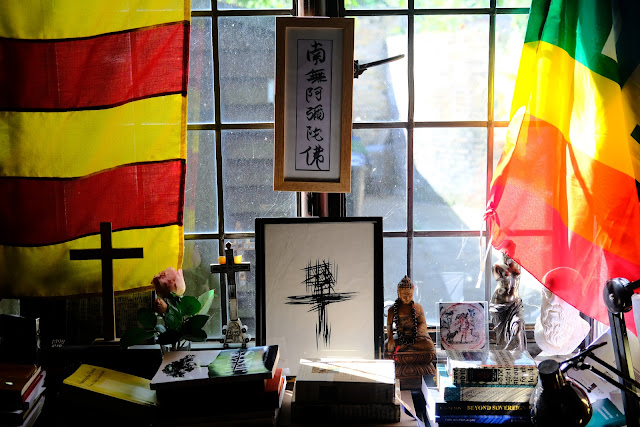 |
| The myōgō/nembutsu is at the top and centre |
At the end of July, as some of you know, we at the Cambridge Unitarian Church were pleased and honoured to welcome Enrique Galvan-Alvarez a
Jodo Shinshu scholar and priest ordained at the
Nishi Hongan-ji temple in Kyoto, Japan. Enrique had joined us for many of the Wednesday Evening Conversations during which, since January, between six and ten of us
explored the classic Jodo Shinshu text, “The Tannisho.” Enrique’s deep knowledge of the Jodo Shinshu tradition were invaluable to our conversations as was his openness to the traditions, insights and concerns of our own Unitarian, Free Christian and Universalist tradition.
 |
| L. to R. Me, Susanna, Riena and Enrique |
As I have mentioned elsewhere, the links between us and Jodo Shinshu Buddhists stretch back to the late nineteenth and early twentieth century both in Japan and the UK (see, for example
HERE). Indeed, one person who had a key role to play in the founding of our own modern congregation here in Cambridge in 1904 was
Joseph Estlin Carpenter who, as an expert in Sanskrit and a pioneer in the study of comparative religion, found many rich and powerful connections between the liberal Christian, Unitarian and Universalist tradition and Jodo Shinshu.Anyway, whilst he was staying with us, Enrique very kindly offered to welcome and pay his personal respects to my new
myōgō/nembutsu (a scroll bearing the name of the Buddha) which hangs in my study. This “scroll” was only recently hand-calligraphed and gifted to me by Jason, the asylum-seeker from Hong Kong who we as a congregation helped at the beginning of the year. Enrique and I were joined in my small study by my wife, Susanna, and an old friend from the Ipswich Unitarian congregation, Riena Jackson, (who had also attended the Wednesday Evening Conversations). It was both a beautiful and moving occasion in itself as well as being a wonderful example of a good interfaith encounter. That we were also renewing a tradition of dialogue between our traditions that stalled in the 1920s thanks, not only to the increasingly fraught political/religious situation in Japan at the time contributed to by US actions in the Pacific (especially Hawaii from the 1890s onwards) but also to
the actions of the American Unitarian Association in the early 1920s, only made what we were doing feel even more special. Indeed, it felt important enough for both Enrique and me to don our most formal religious attire and, afterwards, we went outside into our little Memorial Garden to have our photo taken as a memento of the occasion.




Comments